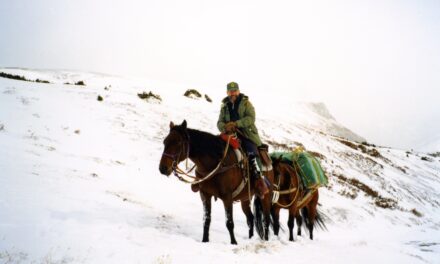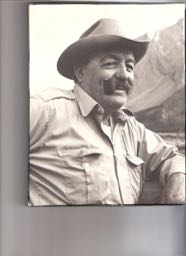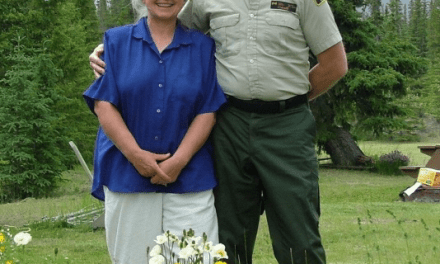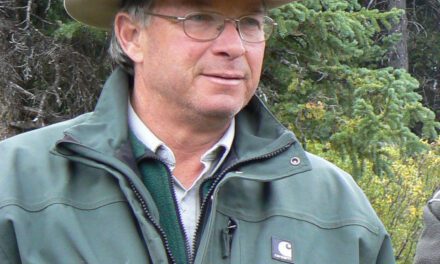(13:49) Hans – Fryatt…
(13:59) Lilo – To us that was just the most beautiful life. And we met John Crawford, he was such a wonderful wildlife photographer. He was from the States and he always came by for coffee. Hans took him climbing. He was not a climber, but he was just so thrilled (with the wildlife). Hans took him up Athabasca.
(14:24) Hans – He was an independent wildlife biologist actually.
(14:29) Lilo – And truly devoted to animal love. He would photograph and take movies of grizzlies and he would say, “Oh, boy, come on boy.” And the grizzly would come! They knew he was a kind man. They (the animals) would never feel threatened and we learned so much from him…We are real animal lovers also. If you treat animals with respect and kindness they would never charge you. It is the aggressiveness of men that causes that. It makes us so sad because we really feel that nowadays we can live in harmony with wildlife. I have a strong belief in that. I advocate about that and often it is so sad because here in this valley it is all gun happy…I would rather live in a national park again too, but you see the big circus going on, the commercialization.
(15:35) Hans – Things have changed a lot too.
(15:39) Lilo – I think in those years, forty years ago, those were the best years…You saw so much wildlife going up the Banff-Jasper Parkway and now it is just all cars, and people and money. It is just the way it is you know. You can’t turn the clock back, but those were wonderful times…
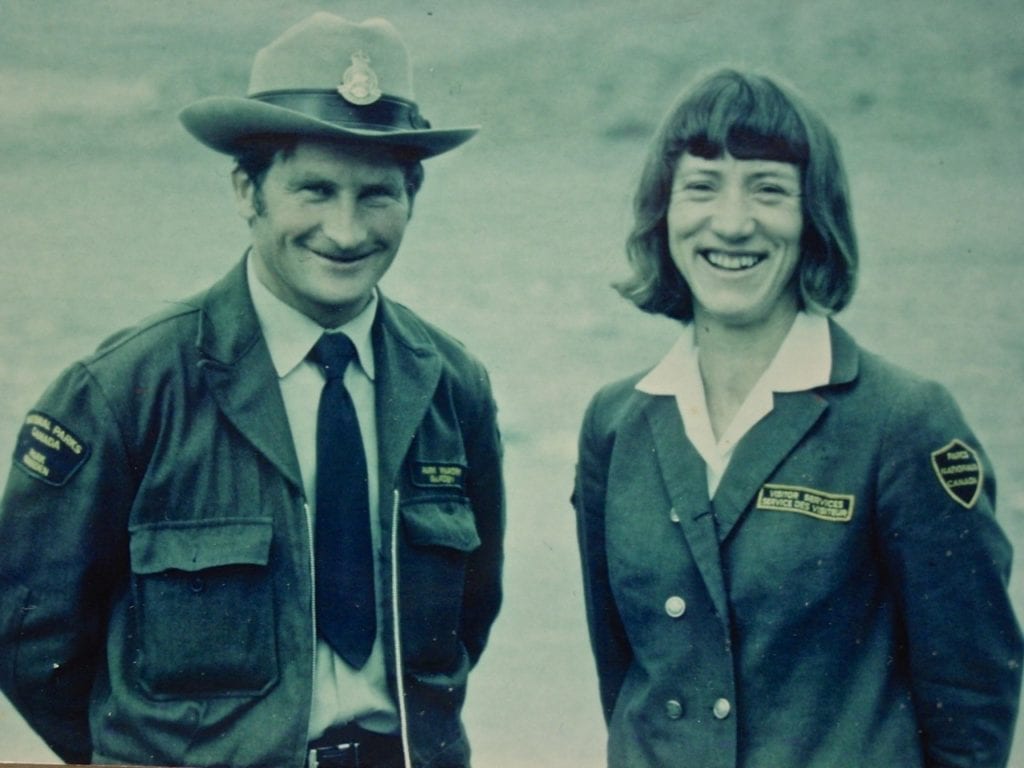
Photo courtesy Hans & Lilo Fuhrer.
(16:15) Hans – It wasn’t the money that made you happy. It was the great times you had and we had the best.
(16:21) Lilo – We always lived very simply and we still (do). We believe in that, absolutely. What really upset us later was when the money and the greed came in, starting the strikes and all that. We thought, “What on earth?” You know we all made good money and we can’t take it with us at the end…We really lived for the nature.
(16:48) Hans – I call it God’s Real Estate that we live in, so it shouldn’t be destroyed or abused. They try all kinds of tricks in this area (the Columbia Valley) to develop, but you go back into parks and you say “Wow, there is still peace.” Even so, changes have occurred quite drastically…
(17:11) Lilo – But you go in the backcountry and there is peace…
(17:17) Hans – You can still go there and be in peace with nature that is for sure. That is what we enjoy so much. There is a difference between nature and culture, of course we have the culture in Europe and when you look at both sides we have the best of both worlds. We enjoy Europe a lot too, we go back and forth quite a bit. We enjoy culture so much too and then you come back here and you have the open area again.
(17:48) Lilo – The wildlife…Europe is just very over populated with people, but we enjoy the old traditions and culture. We do a lot of bicycling…My knees are shot, I have osteoarthritis…it is only bone to bone, I have no cartilage left, but I can bicycle and it is so nice. They have bicycle trails all over and it is cheap with Bed and Breakfasts, 25 Euros. We have our own little place, we inherited my mom’s little house. We enjoy it…we go as much as we can now because we can bicycle and food is extremely cheap there…It is usually for only 40 days…We will go again in April. April is wonderful because it is cold here still and over there the daffodils are out, everything is blooming! And here we don’t need anybody to look after our garden. We have a huge big garden plot. We love gardening also. We do have two cats, but I pay somebody and she feeds the cats twice a day and they have a cat house outside. So that works good.
“So how did you get involved with the warden service?”
(19:41) Hans – See what happened was I was teaching skiing at Mount Norquay and I met Walter Perren who was the Alpine Specialist for Parks Canada, the regional Alpine Specialist. I talked to Walter Perren, one time when we skied together and Walter said, “Well, you could actually if you want to…work for us because we do need skiers and climbers in Parks.” This was in the 1960s, so I told Walter at that time, I actually intended to come over for just one year to Canada, but I would give it a try. The year after I was hired on as a ski patrolman at Sunshine. So I worked at Sunshine and we still had buses to go up and down the road from Healy Creek. We had many times, on a busy, busy weekend maybe 300 skiers. This was a big, big day! During the week we would have generally, maybe 70-100 skiers. There were only two ski lifts, there was the Wawa Bowl and the Strawberry Ski Lift. It was great skiing. Walter said, “Okay, since you are a ski instructor, you can also teach the park wardens to ski.” So that was great. The wardens came up and I gave them instructions. Everybody seemed to be happy and I was very, very happy with the job. I stayed at the ski patrol hut up there and had my meals at the lodge with the White family, Cliff White and of course there was young Cliff and his brother, they were just little boys. It was fun to ski with them and eventually they became park wardens also. (Cliff White was the Fire and Vegetation Specialist for Parks Canada, his brother Brad was a Public Safety Specialist in Banff National Park) The pay at that time wasn’t really that great, I got $1.50/hour.
(22:16) Lilo – But things were cheap.
“Would that have been in the mid 1960s that you were at Sunshine?”
(22:18) Hans – Of course things were cheaper at that time…But $1.50/hour wasn’t that great. People told me, “Why do you work for this cheap outfit? You could make much more money in the private sector.” I said, “It is not really the money, I just enjoy my job…” I thought it was worthwhile to stick with it…Then (there was) an opening at the Columbia Icefields. Yeah, it was 1964/65.
(23:15) Lilo – No, it was 1965 Hans, because we got married in 1965, May, and I worked at the Banff School of Fine Arts and you got the job there. I went back and forth or you came down. That was when I thought, “Oh it is a desolate place. It is only rocks and no green.” I loved the green and I loved Banff. I was really best friends with Nancy. We would just play tennis early in the morning or cycle out to Johnson Lake and go for a swim…She was a tomboy too and we were best friends.
(23:53) Hans – That was the time when with the registration system every climber or hiker had to register out. It was a mandatory system, simply because there weren’t really too many people at that time. Therefore the safety aspect was such that for the ones that went out if they got lost…we went to look for them, or we called a rescue or whatever. That of course has changed over the years because there are more people out there and they look after themselves. But at that time I felt that it was a really, really good system and the people they did appreciate that, all the climbers appreciated that. They liked to come in and register with you. You got their names down and the destination. Then if they didn’t come back at a certain time you started to worry or sometimes weather dependent you had to wait for a night or so because maybe they were overdue because of the weather. It was kind of a common sense operation. One started to develop a feeling for what was going on out there and the nice part of that was that Parks management gave you a lot of leeway about that. They gave you a lot of independence. So you could sort of make up your own decisions about (what had to be done) and that was accepted by the chief (warden) and that was the nice part. Therefore you became sort of an independent player and you knew what was going on, much more than when you always had a boss behind you to tell you what had to be done and so on. We really liked that system.
“So were you considered a seasonal warden?”
(26:00) Hans – No, at that time I had two position numbers, I had one for the summertime and one for the winter. In the summer to register people at the Columbia Icefields, as an assistant sort of to the warden, to the district warden, but that wasn’t yet a warden position. It was just to help them out.
(26:25) Lilo – In 1972 you got your warden position…
(26:38) Hans – In the winter I had a different position number. So I had two position numbers, one in the summer, it was a six month position, and one in the winter, it was also a six month position. It gave me a full year of employment and that was great. Even so the pay wasn’t that high, but there was a lot, a lot of time to do climbs on our days off and so on. In the off time we even made it down to California and the Chief Park Warden in Jasper told me, “Make sure that you are going to be back in time because we need you again at the Columbia Icefields.” That was Mickey McGuire.
(27:29) Lilo – Yeah, we loved it. In the winter we lived in Jasper and in the summer in a trailer at the Columbia Icefields.
“Did you have experience from Switzerland with avalanche control?”
(27:36) Hans – I did the avalanche program (in the winter). Well, actually still at that time Parks ran the ski patrol program as well. We looked after the casualties, the accidents and so on and at the same time we looked after the avalanche control. But then the ski patrol was taken over by the ski operators that was in the 1970s…when that was changed over. Then we remained as the avalanche control workers for the ski areas, so we looked after the avalanche safety. I was a ski instructor. Of course I skied in avalanche terrain, with little knowledge. Where we lived in Switzerland was in a steep avalanche area. It was a common thing to play with the avalanches so to speak! I remember I went ski touring in many areas that I wouldn’t do that anymore today, but I always got away with it. I had some old skis and I fixed up some skins. I went ski touring up to one peak. My dad was always concerned, but more concerned that I was going to be down in time to milk the cows in the stable, than if I would get hurt out on the slopes!
(29:24) Lilo – He was against the skiing.
(29:28) Hans – Yeah, my dad…thought that skiing was a waste of time. This is why I am still skiing I guess! I remember one time I skied an avalanche slope and it was very, very steep and I was all by myself. The day after, I went back up there and the whole slope had slid. I thought, “Oh, that’s too bad, I didn’t ski that today. So we got away with that…but we learned a different way and then of course I got into some courses and schools here in Canada and I learned the art of the avalanche and the snow structure.
(30:31) Lilo – He worked at Rogers Pass for a while with Fred Schleiss.
(30:39) Hans – I worked for one winter on the avalanche control with the people there at the Pass. That was a good learning experience. So from there, in 1971 I became a fulltime warden. That was when things really changed. I remember the pay was better. At one time from $1.50, I got an incredible raise, it was unbelievable. Mickey McGuire (Chief Warden of Jasper National Park) said, “Okay, climbing and skiing, the danger is equivalent to a truck driver. So we can pay Hans as a truck driver.” I got this incredible raise from $1.50 to $1.70/hour and I thought “WOW!” That was unbelievable…But that changed then when I got a fulltime position. That was probably $2.70 at that time when I got a fulltime position. Yeah, that was at Mile 45, we were stationed at Mile 45.
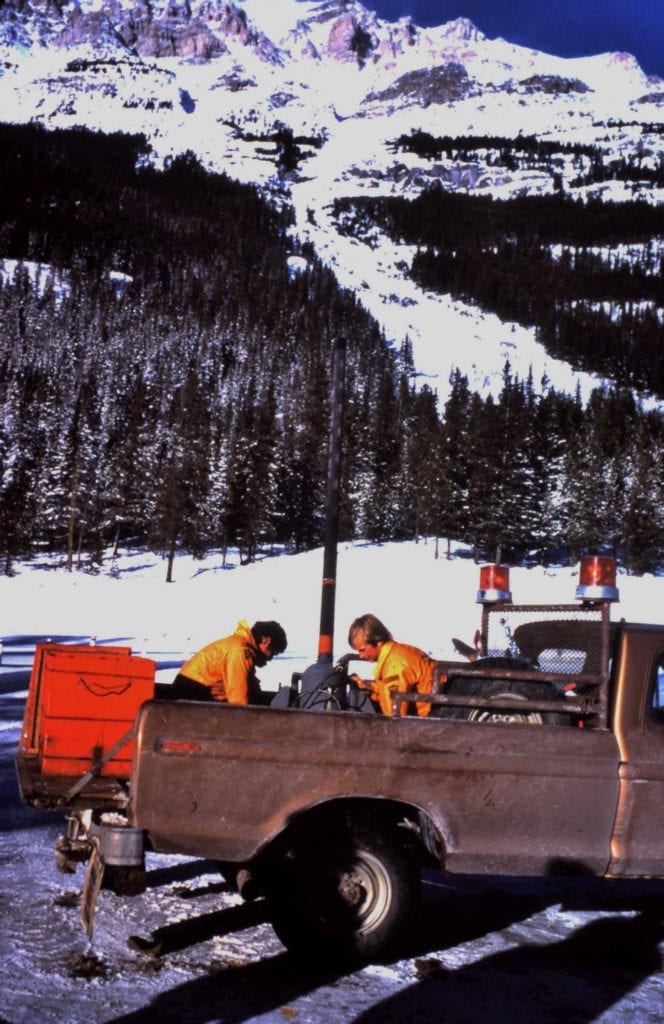

Hans working on Avalanche control. Photos courtesy of Don Mickle
(32:36) Lilo – We had a little garden there and we grew potatoes and carrots that were about that big (demonstrating), but they were carrots…Two years.
“How long were you there?”
(32:55) Hans – Actually at the Columbia Icefields all together we were there for ten summers. Lilo, she ran the information office while I looked after the alpine aspects…public safety, search and rescue…
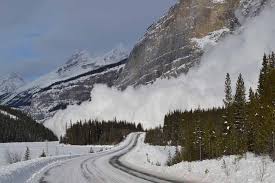
(33:25) Hans – There were some really, really interesting incidents at the Columbia Icefields at that time. I had to look after the motor vehicle accidents and the mountaineering accidents, whatever occurred during that time. But one day there was a phone call. It was sort of a doomy gloomy day at the Icefields. It was rainy, it was cold, it was kind of miserable. Here is this phone call, our call (ring) was two shorts and two longs. This was on the forestry line with the crank phone. I answered the phone and it was the snowmobile operator who ran the tourists up and down the Athabasca Glacier with the snowmobiles. That was a big tourist operation at that time already. The manager told me that they had a really bad accident with one of their operators at the Athabasca Glacier. I didn’t know exactly what happened, but he said, “Come up as fast as you can. Bring your first aid equipment, all your equipment.” At that time we just had basic first aid training. Of course, I had quite a bit of experience doing the ski patrol. I had fixed up a lot of people. I jumped into the truck and I drove up to the moraine, up to the snowmobile operation and here was a snowmobile waiting for me and there was some more staff. I sat in the snowmobile and there was another guy, sort of a scrappy guy sitting beside me. He had long hair, it was sort of in the early 1960s when the hippy era started, you know. This guy was sitting beside me and he had this first aid kit. He said, “Are you going to this accident?” I said, “Yes, I am stationed here at the Columbia Icefields and I am looking after the mountaineering accidents.” I asked him who he was because to me he looked like a hippy. “Well, I am a doctor, an American doctor. I just finished my studies. This is my first trip on an extended holiday. I figured it would be a nice trip to the national parks.” It just happened at that time that they announced over the PA that they badly needed a doctor if a doctor was available to come to this accident. So here we were…we got to the accident site and this was a really, really gruesome accident…What happened was the snowmobile operators had to maintain a road to go up and down the Athabasca Glacier to smooth down the surface so that the snowmobiles could safely travel. They also covered up some crevasses and so on to make it safe for the snowmobiles. For that reason they had to drag a snow cutter or an ice cutter behind a cat, a snowcat. There were two operators, one was in the snowcat and one operator was behind on that cutter. For some reason that mechanism on that cutter didn’t work, it didn’t catch in properly, so the operator on the cutter kicked the axle. He kicked the axle and all of a sudden it got engaged and at the same time it grabbed his shoelace…It grabbed the shoelace, it grabbed his leg and the pin of the ice cutter went right through his boot. It went around his boot and wrapped his leg right around the axle and at the same time it dragged his body under the cutter. The operator of the snowcat saw that and immediately disengaged the axle from going further. But this guy was lying under this heavy, heavy snow cutter and it was impossible for the staff to lift it off the ice because it was extremely heavy. He was totally trapped and he was under there for already a good half an hour because they had tried all the angles to free this guy and it was almost impossible because he was pinned. His leg was wrapped around…So we looked around the scene and the doctor said…”The only thing that we can do is we have to amputate the leg at the scene.” I said, “Do we have to do that?” He said, “Yeah that is the only thing to do.” Well I saw it too. There was no other way to free that man. He was totally conscious during that time. The guy said, “Do whatever you can just to free me, I know that I am going to lose my leg.” He saw that there was no hope. This doctor, his name was Dr. Marshall, it was actually too bad, I never got his name properly from him or his address because it would be really interesting to talk to him. He would probably be my age now too. He was about my age at that time. He said, “Do you have a knife?” I said, “Yes, I do have a Swiss pocket knife.” My Swiss identity tool. I took out my Swiss pocket knife and it was sharp enough. We put a tourniquet around his thigh. At the same time the doctor said the knife wouldn’t be good enough. We needed something stronger, something better. So they went down to the kitchen, the snowmobile kitchen and they got some kitchen knives. They brought up those knives and we had the tourniquet there and we started. I held the leg and the doctor was separating his leg, you know the joint around his knee. Then we slowly got the leg lose, pulled it apart. When we had that done, we could pull him further and then we could move the machine a little further back and the rest of the body would slide under that snow cutter. We got his body loose and his other leg was badly broken as well. From that point, I had this lunch box radio, we didn’t have those walkie talkies. I called the Icefields Centre, my wife she was at the Information Office and she called the ambulance. Of course that was prearranged already that the ambulance would come out of Jasper with another doctor…I took the rest of that leg and unwrapped it off that axle and packed it up in a bag and so on.. Then the other doctor and the ambulance came out from Jasper and he was moved to the Jasper hospital.
